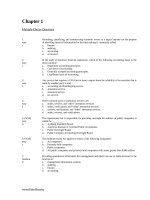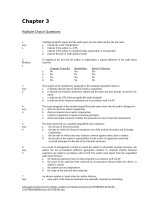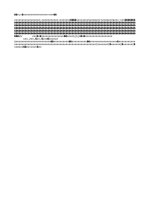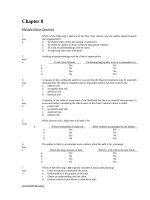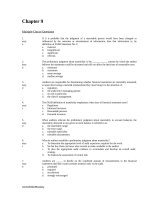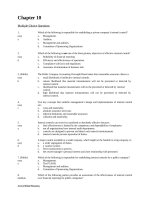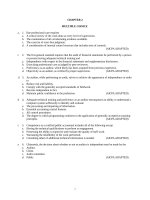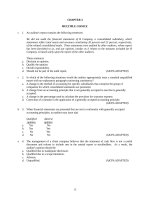Test bank auditing and assurance principles by arens, elder beasley chapter 06
Bạn đang xem bản rút gọn của tài liệu. Xem và tải ngay bản đầy đủ của tài liệu tại đây (368.59 KB, 324 trang )
��#ࡱ#�################>###��
#################;###########=#######����####4###5###6###7###8###9###:###�������
��������������������������������������������������������������������������������
��������������������������������������������������������������������������������
��������������������������������������������������������������������������������
��������������������������������������������������������������������������������
��������������������������������������������������������������������������������
���#%`
###�#�###############��####bjbjN�N�##################
###.Z##,�##,�##m�######
%#######################��##########��##########��##################�###########
######################################################2#######Z�######Z�######Z�
##8###��##t####�##
##2#######��#######�#######�#######�#######�#######�#######�#######�#######�####
##n�######p�######p�######p�######p�######p�######p�##$###��##h###g�##x###��####
###########################�#######################�#######�#######�#######�####
##��###############################�###############�######��######�######�######
�#######�##�############�###############�######n�##############�################
#######################################�######n�##############�######�##r###n�##
T###########################################################################ࡱ###
####�#######�##
###�������#########Z�######��##�###»##############R�###7##��##0###��######л#####
#��######��##�##��######
##############################################################################ࡱ
�
ࡱ###################### #
�#t####�#######�######�#######�#######�#################
######################�#######�#######�######��######��#########################
#############��##X####################################�#######�#######�######��#
######�#######�#######�#######�##############2#######2#######2###�###�
##��##2#######2#######2#######�
######2#######2#######2#######################################################��
��######
################################################################################
################################################################################
################################################################################
################################################################################
################################################################################
################################################################################
################################################################################
###################Chapter 6Multiple-Choice Questions1.#The objective of the
ordinary audit of financial statements is the expression of an opinion on:
##easy#a.
the fairness of the financial statements.##a#b. the accuracy of the
financial statements.###c.
the accuracy of the annual report.###d. the
balance sheet and income statement.#####2.easy#If the auditor believes that the
financial statements are not fairly stated or is unable to reach an conclusion
because of insufficient evidence, the auditor:##c#a. should withdraw from the
engagement.###b. should request an increase in audit fees so that more
resources can be used to conduct the
audit.###c. has the responsibility of
notifying financial statement users through the auditor�s report.###d. should
notify regulators of the circumstances.#####3.#Auditors accumulate evidence
to:##easy#a.
defend themselves in the event of a lawsuit.##d#b.
justify
the conclusions they have otherwise reached.###c.
satisfy the requirements of
the Securities Acts of 1933 and 1934.###d.
enable them to reach conclusions
about the fairness of the financial statements.#####4.easy#The responsibility
for adopting sound accounting policies and maintaining adequate internal control
rests with the:##b#a.
board of directors.###b.
company management.###c.
financial statement auditor.###d. company�s internal audit
department.#####5.easy#The auditor�s best defense when material misstatements
are not uncovered is to have conducted the audit:##a#a.
in accordance with
auditing standards.###b.
as effectively as reasonably possible.###c.
in
a timely manner.###d.
only after an adequate investigation of the management
team.#####6.easy#If management insists on financial statement disclosures that
the auditor finds unacceptable, the auditor can:##a#Issue an adverse audit
report##Issue a qualified audit report###a.b.c.d.#
Yes
No
Yes
No#YesNo
NoYes#####7.easy#If management insists on financial statement disclosures that
the auditor finds unacceptable, the auditor can do all but which of the
following?##b#a. Issue an adverse audit report.###b. Issue a disclaimer of
opinion.###c.
Withdraw from the engagement.###d. Issue a qualified audit
report.#####
8.easy#Which of the following is not one of the reasons that auditors provide
only reasonable assurance on the financial statements?##d#a.
The auditor
commonly examines a sample, rather than the entire population of
transactions.###b.
Accounting presentations contain complex estimates
which involve uncertainty.###c.
Fraudulently prepared financial statements
are often difficult to detect.###d. Auditors believe that reasonable assurance
is sufficient in the vast majority of cases.#####9. (Public)
challenging#In
certifying their annual financial statements, the CEO and CFO of a public
company certify that the financial statements comply with the requirements
of:##c#a.
GAAP.###b. the Sarbanes-Oxley Act.###c. the Securities Exchange Act
of 1934.###d.
GAAS.#####10.#Which of the following statements is most
correct regarding errors and fraud?##easy#a.
An error is unintentional,
whereas fraud is intentional.##a#b. Frauds occur more often than errors in
financial statements.###c.
Errors are always fraud and frauds are always
errors.###d.
Auditors have more responsibility for finding fraud than
errors.#####11. (SOX)
#Which of the following statements is true of a public
company�s financial statements?##easy#a. Sarbanes-Oxley requires the CEO only
to certify the financial statements.##c#b.
Sarbanes-Oxley requires the CFO
only to certify the financial statements.###c. Sarbanes-Oxley requires the CEO
and CFO to certify the financial statements.###d.
Sarbanes-Oxley neither
requires the CEO nor the CFO to certify the financial statements.#####12.#Which
of the following is not one of the three categories of assertions?##easy#a.
Assertions about classes of transactions and events for the period under
audit##b#b. Assertions about financial statements and correspondence to
GAAP###c.
Assertions about account balances at period end###d. Assertions
about presentation and disclosure#####13.easy#If a short-term note payable is
included in the accounts payable balance on the financial statement, there is a
violation of the:##d#a. completeness assertion.###b. existence assertion.###c.
cutoff assertion.###d. classification and understandability
assertion.#####14.#Professional skepticism requires auditors to possess a(n)
______ mind.##easy#a.
introspective##b#b.
questioning###c.
intelligent###d. unbelieving#####15.easyc#The auditor has no
responsibility to plan and perform the audit to obtain reasonable assurance that
misstatements, whether caused by errors or fraud, that are not ________ are
detected.###a.
important to the financial statements###b.
statistically
significant to the financial statements###c.
material to the financial
statements ###d. identified by the client#####16.#Fraudulent financial
reporting is most likely to be committed by whom?##easy#a. Line employees of the
company.##c#b.
Outside members of the company�s board of directors.###c.
Company management.###d.
The company�s auditors.#####17.#Which of the
following would most likely be deemed a direct-effect illegal act?##easy#a.
Violation of federal employment laws.##c#b.
Violation of federal
environmental regulations.###c.
Violation of federal income tax laws.###d.
Violation of civil rights laws.#####18.#The concept of reasonable
assurance indicates that the auditor is:##easy#a.
not an insurer of the
correctness of the financial statements.##a#b. not responsible for the fairness
of the financial statements.###c. responsible only for issuing an opinion on
the financial statements.###d.
responsible for finding all
misstatements.#####19.#Tests of details of balances are specific procedures
intended to:##easy#a.
test for monetary errors in the financial
statements.##a#b. prove that the accounts with material balances are classified
correctly.###c.
prove that the trial balance is in balance.###d.
identify
the details of the internal control system.#####20.#Which of the following is
the auditor least likely to do when aware of an illegal act?##easy#a. Discuss
the matter with the client�s legal counsel.##c#b.
Obtain evidence about the
potential effect of the illegal act on the financial statements.###c. Contact
the local law enforcement officials regarding potential criminal
wrongdoing.###d. Consider the impact of the illegal act on the relationship
with the company�s management.#####21.mediumc#The auditor gives an audit opinion
on the fair presentation of the financial statements and associates his or her
name with it when, on the basis of adequate evidence, the auditor concludes that
the financial statements are unlikely to mislead:###a.
investors.###b.
management.###c. a prudent user.###d.
the reader.#####22.medium#The
responsibility for the preparation of the financial statements and the
accompanying footnotes belongs to:##b#a. the auditor.###b. management.###c.
both management and the auditor equally.###d. management for the
statements and the auditor for the notes.#####23.#When engaged to audit the
financial statements, it is acceptable for the auditor to
draft:##medium######a##The client�s financial statements##The footnotes to the
client�s financial
statements###a.#Yes##Yes###b.#No##No###c.#Yes##No###d.#No##Yes#####24.medium#The
auditor has considerable responsibility for notifying users as to whether or not
the statements are properly stated. This imposes upon the auditor a duty
to:##a#a.
provide reasonable assurance that material misstatements will be
detected.###b.
be a guarantor of the fairness in the statements.###c.
be
equally responsible with management for the preparation of the financial
statements.###d. be an insurer of the fairness in the statements.#####25.
easy#�The auditor should not assume that management is dishonest, but the
possibility of dishonesty must be considered.� This is an example of:##b#a.
unprofessional behavior.###b. an attitude of professional skepticism.###c.
due diligence.###d.
a rule in the AICPA�s Code of Professional
Conduct.#####26.medium#If the auditor were responsible for making certain that
all of management�s assertions in the financial statements were absolutely
correct:##d#a.
bankruptcies could no longer occur.###b. bankruptcies would be
reduced to a very small number.###c.
audits would be much easier to
complete.###d.
audits would not be economically feasible.#####27.medium#The
auditor�s best defense when existing material misstatements in the financial
statements are not uncovered in the audit is:##d#a. the audit was conducted in
accordance with generally accepted accounting principles.###b.
the financial
statements are the client�s responsibility.###c.
the client is guilty of
contributory negligence.###d. the client is guilty of fraudulent
misrepresentation.#####28.#Fraudulent financial reporting is often
called:##medium#a.
management fraud.##a#b. theft of assets.###c.
defalcation.###d. embezzlement.#####29.#Which of the following statements
is usually true?##challenging#a.
It is easier for the auditor to uncover
fraud than errors.##c#b.
It is easier for the auditor to uncover indirecteffect illegal acts than fraud.###c.
The auditor�s responsibility for
detecting direct-effect illegal acts is similar to the
responsibility to
detect fraud.###d.
The auditor�s responsibility for detecting indirecteffect illegal acts is similar to the
responsibility to detect
fraud.#####30.medium#Auditing standards make _____ distinction(s)
between the
auditor�s responsibilities for searching for errors and fraud.##c#a.
little###b. a significant###c.
no###d.
various#####31.medium#In
comparing management fraud with employee fraud, the auditor�s risk of failing to
discover the fraud is:##b#a. greater for management fraud because managers are
inherently more deceptive than
employees.###b.
greater for management
fraud because of management�s ability to override existing internal
controls.###c.
greater for employee fraud because of the higher crime rate
among blue collar workers.###d.
greater for employee fraud because of the
larger number of employees in the organization.#####32.medium#Which of the
following statements is correct with respect to the auditor�s responsibilities
relative to the detection of indirect-effect illegal acts?##a#a. The auditor has
no responsibility for searching for indirect-effect illegal acts.###b. The
auditor has the same responsibility for searching for indirect-effect illegal
acts as any
other potential misstatement that may occur.###c.
Auditors
have responsibility for searching for any illegal act, whether direct-effect or
indirect-effect.###d.
Discovery of indirect-effect illegal acts is
usually easier than discovery of fraud.#####33.medium#When comparing the
auditor�s responsibility for detecting employee fraud and for detecting errors,
the profession has placed the responsibility:##c#a. more on discovering errors
than employee fraud.###b.
more on discovering employee fraud than
errors.###c.
equally on discovering either one.###d. on the senior auditor
for detecting errors and on the manager for detecting employee fraud.#####34.
medium#If several employees collude to falsify documents, the chance a normal
audit would uncover such acts is:##a#a. very low.###b.
very high.###c.
zero.###d. none of the above.#####35.medium#When planning the audit, if
the auditor has no reason to believe that illegal acts exist, the auditor
should:##d#a.
include audit procedures which have a strong probability of
detecting illegal acts.###b. still include some audit procedures designed
specifically to uncover illegalities.###c.
ignore the issue.###d. make
inquiries of management regarding their policies for detecting and preventing
illegal
acts and regarding their knowledge of violations, and then rely on
normal audit procedures
to detect errors, irregularities, and
illegalities.#####36.#When the auditor has reason to believe an illegal act has
occurred, the auditor should:##medium#a. inquire of management only
at one level below those likely to be involved with the
illegality.##c#b.
begin communication with the FASB in accordance with PCAOB
regulations.###c. consider accumulating additional evidence to determine if
there is actually an illegal act.###d.
withdraw from the
engagement.#####37.#When the auditor knows that an illegal act has occurred, the
auditor must:##medium#a.
report it to the proper governmental
authorities.##b#b.
consider the effects on the financial statements,
including the adequacy of disclosure.###c.
withdraw from the
engagement.###d. issue an adverse opinion.#####38. (Public)
#If an auditor
uncovers an illegal act at a public company, the auditor must notify:##medium#a.
local law enforcement officials.##c#b.
the Public Company Accounting
Oversight Board.###c.
the Securities and Exchange Commission.###d.
all of
the above.#####39.#Why does the auditor divide the financial statements into
smaller segments?##medium#a. Using the cycle approach makes the audit more
manageable.##a#b. Most accounts have few relationships with others and so it is
more efficient to break the
financial statements into smaller pieces.###c. The
cycle approach is used because auditing standards require it.###d.
All of
the above are correct.#####40.medium#Why does the auditor divide the financial
statements into segments around the financial statement cycles?##b#a. Most
auditors are trained to audit cycles as opposed to entire financial
statements.###b. The approach aids in the assignment of tasks to different
members of the audit team.###c.
The cycle approach is required by auditing
standards.###d.
The cycle approach allows the auditor to detect indirecteffect illegal acts.#####41.#The most important general ledger account included
in and affecting several cycles is the:##medium#a.
cash account.##a#b.
inventory account.###c. income tax expense and liability accounts.###d.
retained earnings account.#####42.#Management assertions are:##mediuma#a.
implied or expressed representations about accounts, transactions, and
disclosures in the
financial statements.###b.
stated in the footnotes to
the financial statements.###c.
explicitly expressed representations about
the financial statements.###d.
provided to the auditor in the assertions
letter, but are not disclosed on the financial statements.#####43.#Which of the
following statements is true?##medium#a. Audit objectives follow and are
closely related to management assertions.##a#b. Management�s assertions follow
and are closely related to the audit objectives.###c. The auditor�s primary
responsibility is to find and disclose fraudulent management
assertions.###d. Assertions about presentation and disclosure deal with
whether the accounts have been
included in the financial statements at
appropriate amounts.#####44.medium#Which of the following statements is true
regarding the distinction between general audit objectives and specific audit
objectives for each account balance?##b#a.
The specific audit objectives are
applicable to every account balance on the financial statements.###b. The
general audit objectives are applicable to every account balance on the
financial
statements.###c. The general audit objectives are stated in terms
tailored to the engagement.###d.
For any given class of transactions, usually
only one audit objective must be met to conclude the transactions are properly
recorded..#####45.#Which of the following statements about the existence and
completeness assertions is not true?##medium#a. The existence and completeness
assertions emphasize different audit concerns.##c#b. Existence deals with
overstatements and completeness deals with understatements.###c. Existence deals
with understatements and completeness deals with overstatements.###d. The
completeness assertion deals with unrecorded transactions.#####46.#The
occurrence assertion applies to _______.##medium#a. presentation and disclosure
matters##b#b.
classes of transactions and events during the period###c.
account balances###d.
proper classification of income statement
accounts#####47.medium#Which of the following management assertions is not
associated with transaction-related audit objectives?##b#a.Occurrence###b.
Classification and understandability###c. Accuracy###d.
Completeness#####48.#Which of the following statements is not true?
##medium#a. Balance-related audit objectives are applied to account
balances.##d#b.
Transaction-related audit objectives are applied to classes of
transactions.###c.
Balance-related audit objectives are applied to the
ending balance in balance sheet
accounts.###d.
Balance-related audit
objectives are applied to both beginning and ending balances in balance sheet
accounts.#####49.#In testing for cutoff, the objective is to
determine:##medium#a.
whether all of the current period�s transactions are
recorded.##b#b.
whether transactions are recorded in the correct accounting
period.###c.
the proper cutoff between capitalizing and expensing
expenditures.###d.
the proper cutoff between disclosing items in footnotes
or in account balances.#####50.#The detail tie-in objective is not concerned
that the details in the account balance:##medium#a. agree with related
subsidiary ledger amounts.##b#b.
are properly disclosed in accordance with
GAAP.###c. foot to the total in the account balance.###d. agree with the total
in the general ledger.#####51.#The detail tie-in is part of the_______ assertion
for account balances.##medium#a.
classification##b#b.
valuation and
allocation###c.
rights and obligations###d.
completeness#####52.medium#Which
of the following is not a proper match of a transaction-related audit objective
and management assertion?##a#a.
Accuracy and cutoff.###b.
Classification
and classification.###c.
Posting and summarization with accuracy.###d.
Occurrence and occurrence.#####53.#Which of the following statements is
not correct?##medium#a. There are many ways an auditor can accumulate evidence
to meet overall audit objectives.##d#b. Sufficient appropriate evidence must
be accumulated to meet the auditor�s professional
responsibility.###c.
It
is appropriate to minimize the cost of accumulating evidence.###d.
Gathering
evidence and minimizing costs are equally important considerations that affect
the approach the auditor selects.#####54.#Two overriding considerations
affect the many ways an auditor can accumulate evidence:##mediuma#1.
Sufficient appropriate evidence must be accumulated to meet the auditor�s
professional
responsibility.###2.
Cost of accumulating evidence should
be minimized.In evaluating these considerations:###a. the first is more important
than the second.###b.
the second is more important than the first.###c.
they are equally important.###d.
it is impossible to prioritize
them.#####55.mediumb#If the auditor has obtained a reasonable level of assurance
about the fair presentation of the financial statements through understanding
internal control, assessing control risk, testing controls, and analytical
procedures, then the auditor:###a. can issue an unqualified opinion.###b.
can
significantly reduce other substantive tests.###c.
can write the engagement
letter.###d.
needs to perform additional tests of controls so that the
assurance level can be increased.#####56.mediumd#After the auditor has completed
all audit procedures, it is necessary to combine the information obtained to
reach an overall conclusion as to whether the financial statements are fairly
presented. This is a highly subjective process that relies heavily on:###a.
generally accepted auditing standards.###b.
the AICPA�s Code of
Professional Conduct.###c.
generally accepted accounting principles.###d. the
auditor�s professional judgment.#####57.#Which of the following combinations is
correct?##medium#a.
Existence relates to whether the amounts in accounts are
understated.##c#b.
Occurrence relates to whether balances exist.###c.
Existence relates to whether amounts included exist.###d. Occurrence
relates to whether the amounts in accounts occurred in the proper year.#####58.
medium#If an auditor conducted an audit in accordance with auditing standards,
which of the following would the auditor likely detect?##b#a.
Unrecorded
transactions.###b.
Incorrect postings of recorded transactions.###c.
Counterfeit signatures on paid checks.###d.
Fraud involving
collusion.#####59.medium#Which of the following statements best describes the
auditor�s responsibility with respect to illegal acts that do not have a
material effect on the client�s financial statements?##a#a. Generally, the
auditor is under no obligation to notify parties other than personnel within the
client�s organization.###b.
Generally, the auditor is under an obligation to
inform the PCAOB.###c. Generally, the auditor is obligated to disclose the
relevant facts in the auditor�s report.###d.
Generally, the auditor is
expected to compel the client to adhere to requirements of the
Foreign Corrupt
Practices Act.#####60.medium#Which of the following statements best describes
the auditor�s responsibility regarding the detection of fraud?##c#a.
The
auditor is responsible for the failure to detect fraud only when such failure
clearly results from nonperformance of audit procedures specifically described
in the engagement letter.###b.
The auditor must extend auditing procedures
to actively search for evidence of fraud in all situations.###c. The auditor
must extend auditing procedures to actively search for evidence of fraud where
the examination indicates that fraud may exist.###d. The auditor is responsible
for the failure to detect fraud only when an unqualified opinion is
issued.#####61.#The essence of the attest function is to:##medium#a.
assure
the consistent application of correct accounting procedures.##b#b.
determine
whether the client�s financial statements are fairly stated.###c.
examine
individual transactions
so that the auditor may certify as to their validity.###d.detect collusion and
fraud.#####62.medium#The primary difference between an audit of the balance
sheet and an audit of the income statement is that the audit of the income
statement deals with the verification of:##a#a. transactions.###b.
authorizations.###c.
costs.###d. cutoffs.#####63.challenging#The
auditor�s evaluation of the likelihood of material employee fraud is normally
done initially as a part of:##c#a. tests of controls.###b. tests of
transactions.###c.
understanding the entity�s internal control.###d.
the
assessment of whether to accept the audit engagement.#####64.challenging#When
using the cycle approach to segmenting the audit, the reason for treating
capital acquisition and repayment separately from the acquisition of goods and
services is that:##c#a. the transactions are related to financing a company
rather than to its operations.###b. most capital acquisition and repayment cycle
accounts involve few transactions, but each is often highly material and
therefore should be audited extensively.###c. both a and b are correct.###d.
neither a nor b is correct.#####65.#Illegal acts are defined in SAS 54
(AU217)
as: ##challenging#a. violations of laws or government
regulations.##c#b.
violations of laws or government regulations other than
errors.###c.
violations of laws or government regulations other than
fraud.###d. violations of law which would result in the arrest of the
perpetrator.#####66.#Most illegal acts affect the financial
statements:##challenging#a.
directly.##b#b.
only indirectly.###c.
both
directly and indirectly.###d. materially if direct; immaterially if
indirect.#####67.#With respect to the detection of illegal acts, auditing
standards state that the auditor provides:##challenging#a. no assurance that
they will be detected.##a#b. the same reasonable assurance provided for other
items.###c. assurance that they will be detected, if material.###d.
assurance
that they will be detected, if highly material.#####68.challenging#In describing
the cycle approach to segmenting an audit, which of the following statements is
not true?##d#a.
All general ledger accounts and journals are included at least
once.###b. Some journals and general ledger accounts are included in more than
one cycle.###c.
The �capital acquisition and repayment� cycle is closely
related to the �acquisition of goods and services and payment� cycle.###d.
The
�inventory and warehousing� cycle may be audited at any time during the
engagement since it is unrelated to the other cycles.#####69.#Which of the
following journals would be included most often in the various audit cycles?
##challenging#a. Cash receipts journal.##c#b. Cash disbursements journal.###c.
General journal.###d.
Sales journal.#####70.#Transaction cycles begin
and end:##challenging#a.
at the beginning and end of the fiscal
period.##d#b.
each start of the annual audit.###c.
at January 1 and
December 31.###d. at the origin and final disposition of the company.#####71.
challenging#After general audit objectives are understood, specific audit
objectives for each account balance on the financial statements can be
developed. Which of the following statements is true?##a#a.There should be at
least one specific objective for each relevant general objective.###b. There
will be only one specific objective for each relevant general objective.###c.
There will be many specific objectives developed for each relevant general
objective.###d.
There must be one specific objective for each general
objective.#####72.challenging#An auditor should recognize that the application
of auditing procedures may produce evidence indicating the possibility of errors
or fraud and therefore should:##a#a.
plan and perform the engagement with
an attitude of professional skepticism.###b.
not rely on internal controls
that are designed to prevent or detect errors or fraud.###c.
design audit
tests to detect unrecorded transactions.###d. extend the work to audit most
recorded transactions and records of an entity.#####Essay Questions73.
easy#Discuss the differences between errors, frauds, and illegal acts. Give an
example of each.##
#Answer:
The primary difference between errors and frauds is that errors are
unintentional misstatements of the financial statements, whereas frauds are
intentional misstatements. Illegal acts are violations of laws or government
regulations, other than frauds. An example of an error is a mathematical mistake
when footing the columns in the sales journal. An example of a fraud is the
creation of fictitious accounts receivable. An example of an illegal act is the
dumping of toxic waste in violation of the federal environmental protection
laws.##
74.medium#Discuss the actions an auditor should take when the auditor discovers
an illegal act.###Answer:
The auditor should first consider the effects of
the illegal act on the financial statements, including the adequacy of
disclosures. If the auditor concludes that disclosures are inadequate, the audit
report should be modified accordingly. The auditor should also consider the
effect of the illegal act on its relationship with management, and management�s
trustworthiness. Next, the client�s audit committee or others of equivalent
authority should be informed of the illegal act. If the client does not deal
with the illegal act in a satisfactory manner, the auditor should consider
withdrawing from the engagement. Finally, if the client is publicly held, the
auditor may need to report the matter to the SEC. ##75.medium#There are three
broad categories of management assertions. Identify each of these categories.
###Answer:Assertions about classes of transactions and events for the period
under audit.Assertions about account balances at period end.Assertions about
presentation and disclosure.##76.medium#Briefly explain each management
assertion related to classes of transactions and events for the period under
audit.###Answer:Occurrence. Transactions and events that have been recorded have
occurred and pertain to the entity.Completeness. All transactions and events
that should have been recorded have been recorded.Accuracy. Amounts and other
data relating to recorded transactions and events have been recorded
appropriately.Classification. Transactions and events have been recorded in the
proper accounts.Cutoff. Transactions and events have been recorded in the
correct accounting period.##77.medium#Briefly explain each management assertion
related to account balances at period end.###Answer:Existence. Assets,
liabilities, and equity interests exist.Completeness. All assets, liabilities,
and equity interests that should have been recorded have been recorded.Valuation
and allocation. Assets, liabilities, and equity interests are included in the
financial statements at appropriate amounts and any resulting valuation
adjustments are appropriately recorded.Rights and obligations. The entity holds
or controls the rights to assets, and liabilities are the obligation of the
entity.##
78.medium#Briefly explain each management assertion related to presentation and
disclosure.###Answer:Occurrence and rights and obligations. Disclosed events and
transactions have occurred and pertain to the entity.Completeness. All
disclosures that should have been included in the financial statements have been
included.Accuracy and valuation. Financial and other information are disclosed
appropriately and at appropriate amounts.Classification and understandability.
Financial and other information is appropriately presented and described and
disclosures are clearly expressed. ##79.medium#Discuss three reasons why
auditors are responsible for �reasonable� but not �absolute� assurance.
###Answer:Most audit evidence results from testing a sample of a population.
Sampling involves some risk of not uncovering material misstatements.Accounting
presentations contain complex estimates, which inherently involve uncertainty
and can be affected by future events. As a result, the auditor has to rely on
evidence that is persuasive but not convincing.Fraudulently prepared financial
statements are often very difficult for the auditor to detect, especially when
there is collusion among management.##80.medium#Distinguish between management�s
responsibility and the auditor�s responsibility for the financial statements
under audit.###Answer: Management is responsible for adopting appropriate
accounting policies, maintaining adequate internal control, and making fair
representations in the financial statements. The auditor�s responsibility is to
perform an audit designed to provide reasonable assurance of detecting any
material misstatements in the financial statements and to express an opinion on
those financial statements at the conclusion of the audit.##
81.medium#In the context of the audit of sales, distinguish between the
existence and completeness transaction-related audit objectives. State the
effect on the sales account (overstatement or understatement)
of a violation of
each objective.###Answer:
When testing the existence objective for sales,
the auditor�s focus is on whether the sales that have been recorded in the sales
journal actually occurred. In contrast, tests of the completeness objective are
concerned with determining whether all sales that actually occurred have been
recorded in the sales journal. Violations of the existence objective result in
overstatements of sales; violations of the completeness objective result in
understatements of sales.##
82.challenging#Discuss the differences in the auditor�s responsibilities for
discovering (1)
material errors, (2)
material fraud (3)
direct-effect illegal
acts, and (4)
indirect-effect illegal acts.###Answer: Auditing standards make no
distinction between the auditor's responsibilities for searching for errors and
fraud. In either case, the auditor must obtain reasonable assurance about
whether the statements are free of material misstatements. The standards also
recognize that fraud is often more difficult to detect because management or the
employees perpetrating the fraud attempt to conceal the fraud. Still, the
difficulty of detection does not change the auditor's responsibility to properly
plan and perform the audit to detect material misstatements, whether caused by
error or fraud. The auditor�s responsibility for uncovering direct-effect
illegal acts is the same as for errors and fraud. However, the auditor is not
required to search for indirect-effect illegal acts unless there is reason to
believe they exist.##83.challenging#A financial statement audit typically
consists of four phases. Identify each of these four phases of an audit and
discuss the major activities performed by the auditor in each phase.###Answer:
Phase I: Plan and design an audit approach. In this phase, the auditor
obtains an understanding of the client�s entity and its environment. In
addition, the auditor obtains an understanding of the client�s internal control
and assesses the risk of material misstatement. Phase II: Perform tests of
controls and substantive tests of transactions. In this phase, the auditor tests
those internal controls he/she believes may be effective at preventing or
detecting misstatements. In addition, the auditor performs substantive tests of
transactions to verify the monetary amounts of transactions.
Phase III:
Perform analytical procedures and tests of details of balances. In this phase,
the auditor performs analytical procedures to assess the overall reasonableness
of transactions and balances. In addition, tests of details of balances are
performed to test for monetary misstatements in the financial statements.
Phase IV: Complete the audit and issue an audit report. In the last phase
of the audit, the information obtained in the previous phases is combined to
reach an overall conclusion as to whether the financial statements are fairly
presented. An audit report is then issued based on this conclusion.##84.
challenging#Discuss some precautionary actions an auditor should take when there
is a moderate or high risk of management fraud.###Answer: Some precautionary
actions an auditor should take when there is a moderate or high risk of
management fraud include:Critically challenging the client�s choice of
accounting principles.Assigning more experienced personnel to the engagement.
Doing more audit work at year-end instead of at interim dates.Closely
supervising assistants and other inexperienced staff.Performing additional or
more effective audit procedures.In extreme situations, the auditor should
consider withdrawing from the engagement.##
Other Objective Answer Format Questions85.medium#Match seven of the terms (a-k)
with the definitions provided below (1-7)
:###a. Tests of details of balances###b.
Tests of controls###c. Substantive tests of transactions###d.
Analytical procedures###e.
Transaction-related audit objectives###f.
Management assertions###g.
Balance-related audit objectives###h.
Fraud###i. Illegal act###j. Error###k. Management fraud##h#
1. An
intentional misstatement of the financial statements.##e#
2. A set of six
audit objectives the auditor must meet, including timing, posting and
summarization, and accuracy.##f#
3. Implied or expressed representations
made by the client about classes of transactions, account balances and
disclosures in the financial statements.##a#
4. Audit procedures testing
for monetary misstatements to determine whether the balance-related audit
objectives have been satisfied for each significant account balance.##g#
5.
A set of nine audit objectives the auditor must meet, including
completeness, detail tie-in, and rights and obligations.##b#
6. Audit
procedures designed to test the effectiveness of control policies and
procedures.##d#
7. Use of comparisons and relationships to assess whether
account balances or other data appears reasonable.##86.challenging#Below are
five audit procedures, all of which are tests of transactions associated with
the audit of the sales and collection cycle. Also below are the six general
transaction-related audit objectives and the five management assertions. For
each audit procedure, indicate (1)
its audit objective, and (2)
the management
assertion being tested.###
Audit Objectives Assertions###A.
Occurrence V.
Occurrence###B.
Completeness
W.
Completeness###C. Accuracy
X.
Accuracy###D.
Posting and summarization
Y.
Classification###E.
Classification
Z.
Cutoff###F. Timing##
#1.
Vouch recorded sales from the sales journal to the file of bills of
lading.##A#
(1)
.##V#
(2)
.###2.
Compare
dates on the bill of lading, sales invoices, and sales journal to test for
delays in recording sales transactions.##F#
(1)
.##Z#
(2)
.###3.
Account for the sequence of prenumbered bills of
lading and sales invoices.##B#
(1)
.##W#
(2)
.###4.
Trace from a sample of prelistings of cash receipts to the cash
receipts journal, testing for names, amounts, and dates.##B, C#
(1)
.##W, X#
(2)
.###5.
Examine customer order forms for
credit approval by the credit manager.##A#
(1)
.##V#
(2)
.##87.challenging#Below are five audit procedures, all of
which are tests of transactions associated with the audit of the acquisition and
payment cycle. Also below are the six general transaction-related audit
objectives and the five management assertions. For each audit procedure,
indicate (1)
its audit objective, and (2)
the management assertion being tested.
###
Audit Objectives Assertions###A.
Occurrence V.
Occurrence###B.
Completeness
W.
Completeness###C. Accuracy
X.
Accuracy###D.
Posting and summarization
Y.
Classification###E.
Classification
Z.
Cutoff###F. Timing###1. Foot the purchases journal and trace the
totals to the related general ledger accounts.##D#
(1)
.##X#
(2)
.##
#2.
Recompute the cash discounts taken by the client.##C#
(1)
.##X#
(2)
.###3.
Compare dates on cancelled checks with the
bank cancellation date.##F#
(1)
.##Z#
(2)
.
###4. Trace from a sample of cancelled checks to the cash disbursements
journal.##B#
(1)
.##W#
(2)
.##
#5.
Examine supporting documentation for a sample of transactions for
authorized payee and amount and to determine services or goods were
received.##A#
(1)
.##V#
(2)
.##
88.challenging#Below are five audit procedures, all of which are tests of
balances associated with the audit of accounts receivable. Also below are the
eight general balance-related audit objectives and the four management
assertions. For each audit procedure, indicate (1)
its audit objective, and (2)
the management assertion being tested.### Audit Objectives Assertions###A.
Existence
V.
Existence###B.
Completeness
W.
Completeness###C. Accuracy
X.
Valuation and allocation###D.
Classification
Y.
Rights and obligations###E.
Cutoff
###F.
Detail tie-in###G.
Realizable value###H.
Rights and
obligations######1.
Obtain an aged listing of accounts receivable. For a
sample of individual customers on the listing, agree the customer�s name,
amount, and other information with the corresponding information in the accounts
receivable master file.##F#
(1)
.##X#
(2)
.
###2. Examine details of sales for five days before and five days after year-end
to determine whether sales have been recorded in the proper period.##E#
(1)
.##X#
(2)
.###3.
Assess the
reasonableness of the balance in the allowance for doubtful accounts.##G#
(1)
.##X#
(2)
.###4.
Inquire as to whether
any accounts receivable have been factored or sold during the period.##H#
(1)
.##Y#
(2)
.###5.
Inquire as to whether
there are any receivables from related parties.##D#
(1)
.##X#
(2)
.##89.easyb#Responsibility for the fair presentation of
financial statements rests equally with management and the auditor.a. Trueb.
False##90.easyb#Errors are usually more difficult for an auditor to detect
than frauds.a.
Trueb.
False##
91.easyb#Auditors have found that the most efficient way to conduct audits is to
focus primarily on testing classes of transactions and performing minimal or no
tests of ending account balances. a.
Trueb.
False##92.easya#When an
auditor has reduced assessed control risk based on tests of controls, he or she
may then reduce the extent to which the accuracy of the financial statement
information directly related to those controls must be supported through the
accumulation of evidence using substantive tests.a. Trueb.
False##93.easy
b#Tests of details of balances typically involve the use of comparisons and
relationships to assess the overall reasonableness of account balances.a.
Trueb.
False##
94.easya#Other than inquiring of management about policies they have established
to prevent illegal acts and whether management knows of any laws or regulations
that the company has violated, the auditor should not search for indirect-effect
illegal acts unless there is reason to believe they may exist.a. Trueb.
False##95.easya#When an auditor believes that an illegal act may have
occurred, the first step he or she should take is to inquire of management at a
level above those likely to be involved in the potential illegal act.a.
Trueb.
False##96.mediumb#Audits are expected to provide a higher
degree of assurance for the detection of material frauds than is provided for an
equally material error.a.
Trueb.
False##97.mediuma#Auditors have a
higher degree of responsibility for detecting direct-effect illegal acts than
indirect-effect illegal acts.a.
Trueb.
False##98.mediumb#The auditor�s
first course of action when an illegal act is uncovered should be to immediately
notify the appropriate authorities, including but not limited to the police, and
for publicly held companies, the Securities and Exchange Commission.a. Trueb.
False##99.mediumb#Under the cycle approach to segmenting an audit,
transactions recorded in different journals should never be combined with the
general ledger balances that result from those transactions.a.
Trueb.
False##100.mediumb#General transaction-related audit objectives vary from
audit to audit, depending on the nature and characteristics of the client�s
business and industry.a.
Trueb.
False##
101.mediuma#The audit objective of posting and summarization is associated with
the management assertion of accuracy.a. Trueb.
False##102.mediumb#Balancerelated audit objectives are usually applied to the ending balance in income
statement accounts; transaction-related audit objectives are usually applied to
transactions reflected in balance sheet accounts.a. Trueb.
False##103.
mediuma#The transaction-related audit objective of timing is related to the
assertion of cutoff.a. Trueb.
False##104.mediuma#The effect of a violation
of the existence transaction-related audit objective for the sales account would
be an overstatement of that account.a.
Trueb.
False##105.mediumb#The
effect of a violation of the completeness transaction-related audit objective
for cash disbursements transactions would be an overstatement of cash
disbursements.a. Trueb.
False##106.mediumb#The transaction-related audit
objective that deals with whether recorded transactions have actually occurred
is the completeness objective.a.
Trueb.
False##107.mediuma#The general
balance-related audit objective that deals with determining that details in the
account balance agree with related master file amounts, foot to the total in the
account balance, and agree with the total in the general ledger is the detail
tie-in objective.a.
Trueb.
False##108.mediuma#The cutoff objective,
�transactions near the balance sheet date are recorded in the proper period,� is
a balance-related audit objective.a.
Trueb.
False##109.mediumb#For a
private company audit, tests of controls are normally performed only on those
internal controls the auditor believes have not been operating effectively
during the period under audit.a.
Trueb.
False##110.mediuma#An audit
generally provides no assurance that indirect-effect illegal acts will be
detected.a. Trueb.
False##111.mediuma#When an auditor believes there is a
moderate or high risk of management fraud, the auditor will normally do less
audit work at interim dates instead of at year-end.a. Trueb.
False##
112.challengingb#An auditor must inform a client�s audit committee of an illegal
act discovered during an audit in writing.a.
Trueb.
False##113.
challengingb#The objective of the audit of financial statements by an
independent auditor is to verify that the financial statements are free of
misstatements and accurately represent the company�s financial position and
results of operations.a.
Trueb.
False##114.challenginga#The auditor�s
responsibility for uncovering direct-effect illegal acts is the same as for
fraud.a.
Trueb.
False######Arens/Elder/Beasley�
################################################################################
################################################################################
################################################################################
################################################################################
#################################################
#######$###
%###&###�###�###�###########/###0###3###6###7###=###>###B###C###E###F###G###J###
K###L###O###\###^###�###�#######
###C###D###f###g###�###�###�###�###�###�###�###�###�����ǺǬǬǠ��������������������
���������w�################hyt�##h�#�#5#�CJ##OJ##QJ####h�a##CJ##OJ##QJ##^J#####h
#N###h�#�#CJ##OJ##QJ##^J#####h�#�#CJ##OJ##QJ##^J#####h�a###h�#�#>*#CJ##OJ##QJ###
#h#A�##h�#�#CJ##OJ##QJ#####h�#�#CJ##OJ##QJ#####h�#�####h�#�#OJ##QJ#####h�#�#>*#O
J##QJ####h>#�#>*#OJ##QJ####h*U###h>#�#5#�CJ(#OJ##QJ##aJ(##,####
#######
%###&###)
###�###�###�###�###�############�############�############�############
�############�############�############�############�###########################
################################################################################
#####################P##kd#####$##$#If#####�l##�0##���#�$##f####################
#################
t#####�#h%#�####�####�####�###�#�####�###�#�####�###�#�####�###�4�###
#l#a�###yt�#�#####$#�###�#�#$#If####a$#gdL@�#
###$##$#If####a$#gdL@�##########$#a$#gd�#�##
####m�##��##��##################################################################
################################################################################
################################################################################
################################################################################
################################################################################
################################################################################
################################�###�###�###�###�###�####
##�############�############�############A############�############�############
#########################P##kd�####$##$#If#####�l##�0##���#�$##f################
#####################
t#####�#h%#�####�####�####�###�#�####�###�#�####�###�#�####�###�4�###
#l#a�###yt�#�#####$#�###�#�#$#If####a$#gdL@�#
